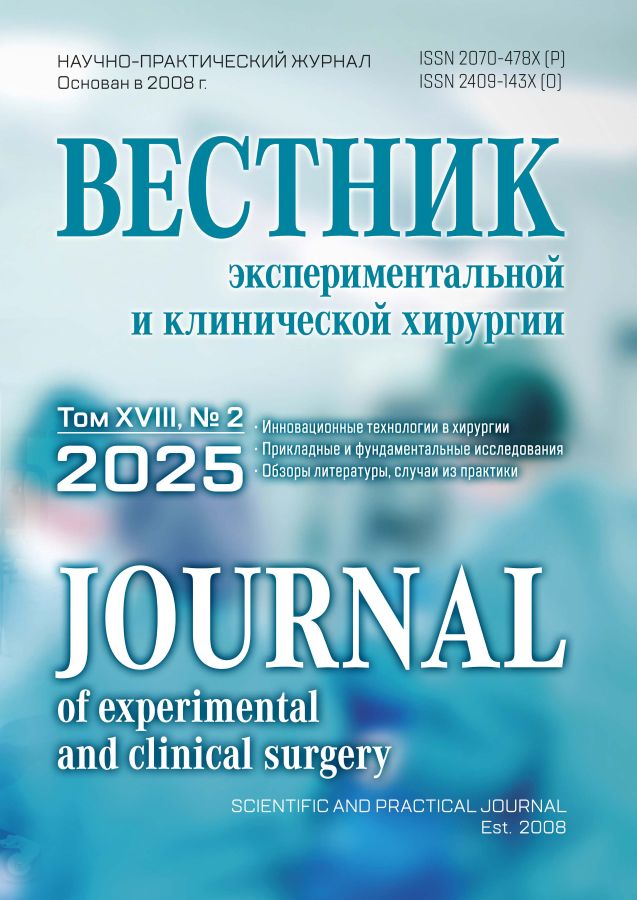A Model of Median Ventral Hernia in Acute Experiment
- Authors: Fedoseev A.V.1, Pavlov A.V.1, Inyutin A.S.1, Glukhovets I.B.1, Kharlamova T.M.1, Yershov A.A.1
-
Affiliations:
- Pavlov Ryazan State Medical University
- Issue: Vol 18, No 2 (2025)
- Pages: 90-97
- Section: Original articles
- URL: https://vestnik-surgery.com/journal/article/view/1891
- DOI: https://doi.org/10.18499/2070-478X-2025-18-2-90-97
- ID: 1891
Cite item
Abstract
Introduction. The treatment of ventral hernia is still of great current interest. If faced with large hernias, a surgeon addresses two problems that can worsen clinical outcomes: intra-abdominal hypertension and excessive tissue tension when suturing the wound. Experimental testing of various hernioplasty techniques considering the tension of the edges of the simulated hernial defect and intra-abdominal pressure is of great importance for improving clinical outcomes of surgical treatment and reducing the number of relapses. Modern hernioplasty techniques are to be thoroughly analyzed in terms of their effectiveness and impact on damaged tissues. Study of the tension mechanics, load distribution on the sutures, dynamics of intra-abdominal pressure during surgery allows identifying the most optimal techniques, which significantly increases the potential successful outcomes of the intervention.
The aim of the study was to create and test a simulated ventral hernia with controlled indices of intra-abdominal hypertension and aponeurosis tension in an acute experiment in animals.
Materials and methods. The study involved 15 pigs weighed 30-35 kg. A special device consisting of an elastic balloon fixed on a tube, a manometer and a squeeze pressure pump was applied to create intra-abdominal hypertension. The tension of the aponeurosis was measured in newtons (N) using an original device equipped with a tensiometer and a monitor.
Results. Intra-abdominal hypertension was simulated by introducing an elastic balloon on a tube into the animal's abdominal cavity through a mini-access, through which air was pumped using a squeeze pressure pump. The pressure value was recorded by the manometer. With total longitudinal dissection of the white line of the abdomen (without damage to the peritoneum), edges of the aponeurosis diverged, which simulated a hernial defect. When intra-abdominal pressure reached 39-41 mm Hg (on average 40,00 ± 0.84) and aponeurosis tension reached 3.8 N, edges of the aponeurosis diverged for three to seven cm (on average 4.9 ± 1.9). One animal with a simulated ventral hernia was exposed to anterior separation plastic surgery according to Ramires II. The tension of the aponeurosis decreased by 52%, intra-abdominal hypertension - by 54%.
Conclusion. The proposed technique for simulating a median ventral hernia allows for an acute experiment, which reduces the time of the experimental study and the material costs associated with the management of the animal. The proposed technique allows not only regulating the initial and final level of aponeurosis tension and intra-abdominal pressure, but also monitoring these parameters at all stages of surgical intervention.
Keywords
Full Text
About the authors
Andrey V. Fedoseev
Pavlov Ryazan State Medical University
Author for correspondence.
Email: colobud@yandex.ru
M.D., Professor, Head of the Department of General Surgery with a Course of Traumatology and Orthopedics
Russian Federation, RyazanArtyom V. Pavlov
Pavlov Ryazan State Medical University
Email: av.pavlov-rzgmu@yandex.ru
M.D., Professor, Head of the Department of Anatomy
Russian Federation, RyazanAlexander S. Inyutin
Pavlov Ryazan State Medical University
Email: Aleksandr4007@rambler.ru
M.D., Associate Professor, Professor at the Department of General Surgery with a Course of Traumatology and Orthopedics
Russian Federation, RyazanIlya B. Glukhovets
Pavlov Ryazan State Medical University
Email: gluhoveci@gmail.com
Ph.D., Associate Professor at the Department of Histology, Pathological Anatomy and Medical Genetics
Russian Federation, RyazanTatyana M. Kharlamova
Pavlov Ryazan State Medical University
Email: xarlamova2018@inbox.ru
Postgraduate Student at the Department of General Surgery with a Course of Traumatology and Orthopedics
Russian Federation, RyazanArtyom A. Yershov
Pavlov Ryazan State Medical University
Email: levniko137@gmail.com
Senior Laboratory Assistant at the Department of General Surgery with a Course of Traumatology and Orthopedics
Russian Federation, RyazanReferences
- Uzalaeva SHA, Sanova AZ, Kadokhova LA. Prevention of surgical diseases. Molodoi uchenyi. 2018;27(213):60-63. (in Russ.)
- Ermolov AS, Blagovestnov DA, Alekseev AK, Upyrev AV, Yartsev PA, Shlyakhovsky IA, Koroshvili VT, Burbu AV. Surgical treatment of patients with large and giant postoperative ventral hernias. Khirurgiya. Zhurnal im. N.I. Pirogova. 2019;9:38-43. doi: 10.17116/hirurgia201909138. (in Russ.)
- Mirmullaev ZSH. Analysis of the incidence of seromas in patients with postoperative ventral hernia after non-protracted hernioplasty. Molodoi uchenyi. 2021;16(358):44-47. (in Russ.)
- Bafitis H, Arboleda V, Bernal I. Component separation: a case report of hybrid and synthetic absorbable mesh use for complex large ventral hernia reparation. Cureus. 2023;15(3):e36347. doi: 10.7759/cureus.36347
- Gaspar FJL, Midtgaard HG, Jensen AK, Jorgensen LN, Jensen KK. Endoscopic anterior component separation and transversus abdominus release are not associated with increased wound morbidity following retromuscular incisional hernia repair. World J Surg. 2023;47(2):469-476. doi: 10.1007/s00268-022-06789-2
- Fry BT, Howard RA, Thumma JR, Norton EC, Dimick JB, Sheetz KH. Surgical Approach and Long-Term Recurrence After Ventral Hernia Repair. JAMA Surg. 2024;159(9):1019–1028. doi: 10.1001/jamasurg.2024.1696
- Fedoseev AV, Rybachkov VV, Inutin AS, Lebedev SN. Prevention of postoperative hernias during median laparotomy. Meditsinskii vestnik Severnogo Kavkaza. 2019;14(1):16-18. (in Russ.)
- Jou BS, Perzia BS, Mellia BA, Carey BS, Kapadia BS, Singh G, Marquez JE, Khan SU. Analysis of long-term outcomes of ventral hernia repair performed by plastic surgeons and general surgeons: a single-institution review. Plastic and Reconstructive Surgery. 2019;7(8S-1):127-128. doi: 10.1097/01.GOX.0000584960.37395.b9
- Celestin AR, Barron S, Haddad A, Jia E, Morgenstern M, Diamond S, Plaster B, Cauley RP, Morris DJ. Technique of abdominal wall tissue expansion for the treatment of massive complicated ventral hernias. Plastic & Reconstructive Surgery. 2022;10(2):e4095. doi: 10.1097/GOX.0000000000004095
- Vetrone G, Linguerri R, Negosanti L, Masetti M. Intraperitoneal mesh open repair without dissection technique for large ventral hernia repair: an alternative to component separation technique. Minerva Surgery. 2023;78(4):361-370. doi: 10.23736/s2724-5691.23.09849-0
- Bosley ME, Felix Z, Salgado-Garza G, Lansing S and Nikolian VC (2024) Short-Term Outcomes of Transabdominal Preperitoneal Ventral Hernia Repair With Rectus Aponeuroplasty (TAPPRA) for the Management of Incisional Hernias. J. Abdom. Wall Surg. 3:13195. doi: 10.3389/jaws.2024.13195
- Govorovskaya EA, Gnilosyr BB, Kozlov BB, Khmara MB. Surgical treatment of postoperative ventral hernias taking into account the parameters of tissue tension. Byulleten' meditsinskikh internet-konferentsii. 2020;10(12):331-332. (in Russ.)
- Tasdelen HA. Open posterior component separation with transversus abdominis release (TAR) for large incisional abdominal wall hernias: Results from a single center. Medicine. 2022;11(4):1487-93. doi: 10.5455/medscience.2022-05-119
- Serafio-Gómez JL, Aragón-Quintana C, Bustillos-Ponce M, Varela-Barraza O, Silva B. Effective Management of Giant Ventral Hernias: A Comprehensive Approach Combining Preoperative Botulinum Toxin Application, Modified Ramírez's Component Separation, and Rives-Stoppa Hernioplasty. Cureus. 2023;15(11):e48967. doi: 10.7759/cureus.48967
- Goda MH, Abdelrahim HS, Elmaleh HM, Amer AF, Fadl EMA. Transversus abdominis release versus anterior component separation in ventral abdominal hernia-a prospective comparative study. Surgery Gastroenterology Oncology. 2022;27(3):198-207. doi: 10.21614/sgo-460
- Ismailov GM, Magomedov MM, Magomedov AA. Modeling of ventral hernia and its experimental results. Medicus. 2022; 3(45):55-59. (in Russ.)
- Whitehead Clarke T, Karanjia R, Banks J, Beynon V, Parker S, Sanders D, Mudera V, Windsor A, Kureshi A. The experimental methodology and comparators used for in vivo hernia mesh testing: a 10-year scoping review. Hernia. 2022;26:297–307. doi: 10.1007/s10029-020-02360-x
- Cerullo A, Giusto G, Maniscalco L, Nebbia P, von Degerfeld MM, Serpieri M, Vercelli C, Gandini M. The Effects of Pectin–Honey Hydrogel in a Contaminated Chronic Hernia Model in Rats. Gels. 2023; 9(10):811. doi: 10.3390/gels9100811
- Fedoseev AV, Kharlamova TM, Pavlov AV, Lebedev SN, Inyutin AS, Budarev VN. Sposob modelirovaniya ventral'noi gryzhi. Patent RF na izobretenie № 2792283 ot 21.03.2023. (in Russ.)
- Anne P. Ehlers, Alex K. Hallway, Sean M. O'Neill, Brian T. Fry, Ryan A. Howard, Jenny M. Shao, Michael J. Englesbe, Justin B Dimick, Dana A Telem, Grace J Kim. Variation in approach for midsize (4-6cm) ventral hernias across a statewide quality improvement collaborative. Surgery in Practice and Science. 2024;16:100235. doi: 10.1016/j.sipas.2024.100235.
- Fedoseev AV, Shklyar VS, Lebedev SN, Inyutin AS. Magnetic resonance imaging in the diagnosis for predictors of ventral hernia recurrence. Rossiiskii mediko-biologicheskii vestnik im. akademika I.P. Pavlova. 2021;29(4):505-512. doi: 10.17816/PAVLOVJ83095 (in Russ.)
- Mughal M, Ross D, Ross D. The open perforator sparing anterior component separation. International Journal of Abdominal Wall and Hernia Surgery. 2022;5(1):21-25. doi: 10.4103/ijawhs.ijawhs_52_21
- Abdebaky MM, Magid AMI, Gamal EOA. Prospective comparative study between open perforator-preserving anterior component separation and transversus abdominis release operation in patients with large midline incisional hernia. The Egyptian Journal of Surgery. 2022;41(1):52-261. doi: 10.4103/ejs.ejs_341_21
- Сobani D, Dogjani A, Gjata A, Haxhirexha K, Сeliku E, Kolani H, Kaсi M. Incisional abdominal hernias, some consideration about it. International Journal of Medical Science and Clinical Invention. 2021;8(10):5683–5686. doi: 10.18535/ijmsci/v8i10.02.
- Ramirez OM, Ruas E, Dellon AL. “Components separation” method for closure of abdominal-wall defects: an anatomic and clinical study. Plastic Reconstructive Surgery. 1990;86(3):519–526. doi: 10.1097/00006534-199009000-00023.
- Shapovaliants SG, Mikhalev AI, Mikhaleva LM, Dzavaryan TG, Pulatov MM. Morphofunctional assessment of the influence of various methods of separation of the anterior abdominal wall on the increase in the volume of the abdominal cavity. Rossiiskii mediko-biologicheskii vestnik im. akademika I.P. Pavlova. 2017; 25 (3): 210. doi: 10.23888/PAVLOVJ20173443-452
Supplementary files


















